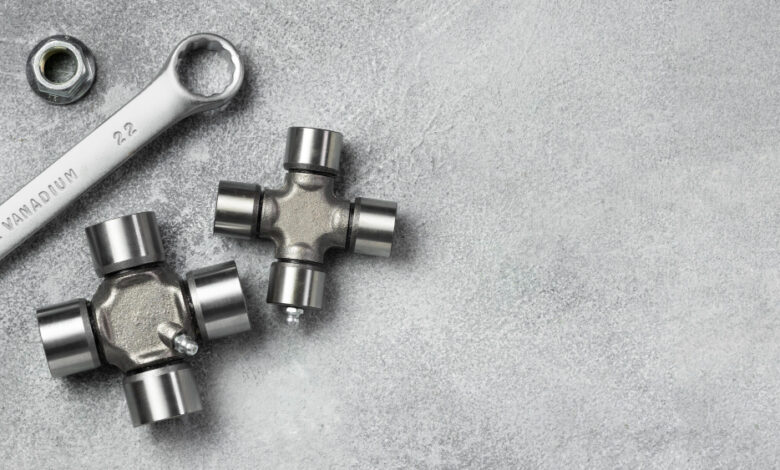Universal Joint Cross: Essential Component in Power Transmission

It is commonly referred to as a universal joint cross, U-joint cross, or simply a cross joint. This is an essential mechanical component used in transmitting power, especially for vehicles and other industrial equipment. A universal joint cross allows the conveyance of rotational force between two shafts that are not aligned with each other. This is critical in any system where some form of angular displacement or flexibility in alignment is needed to enable it to move smoothly and efficiently.
What is a Universal Joint Cross?
A universal joint cross is a mechanical linkage used to connect two shafts at an angle such that there is a possible transfer of a rotational motion between them. It consists of a cross-shaped piece, referred to as the spider, and four bearings at its ends. The bearings are housed in yokes and the shafts to be connected must be attached to the yokes. The cross joint is also able to allow two shafts to move in different directions but still transmit rotational power between them.
The universal joint cross is widely used in most automotive drive shafts, among other machinery and equipment that may require flexible or misaligned shaft connections. It was designed to accommodate angular misalignments during the operation stage, thus resulting in smooth performance under varying conditions.
Working Principle of the Universal Joint Cross
This cross works based on a principle of transferring rotation motion through a flexible joint. While one shaft is in rotation, the torque can be transferred to another shaft through the crosspiece and bearings. It helps another shaft rotate at the same rate of revolution, but from a different angle; this might help transfer power with misalignment of the two shafts.
However, the U-joint cross is not technically a true CV (constant velocity). When it rotates, there is some apparent variance in the angular velocity on both the shafts. Such movement can cause vibrations in the system, which is described as a non-uniform motion. Therefore, double U-joints or constant velocity joints would be used to avoid such effects in applications requiring constant rotational speed.
Key Features and Advantages
Shaft Misalignment Flexibility
The universal joint cross allows the ability to transfer power from one shaft to another. These shafts do not necessarily have to align in a straight line. This is very essential in applications such as a vehicle’s drive shafts where the transmission and the axle are not in a straight line with one another.
High Load-Carrying Ability High durability:
The cross used in a universal joint is built from strong materials like hardened steel or alloy for withstanding the most rigorous loads and operating conditions. Such durability is very important for heavy-duty vehicle applications, off-road machinery, and other types of industrial equipment.
Compact and Simple Design
The U-joint cross is compact and simple in design, hence it can easily be integrated into any system. Furthermore, the minimalist nature of this cross brings about reduced maintenance requirements and easier replacement when need becomes inevitable.
Versatility
The universal joint cross can be used in various industries like automotive, aerospace, manufacturing among many others. Their versatility develops from their ability to take in angular misalignments while transmitting rotational power effectively.
Universal Joint Cross Applications
The universal joint cross is widely used in a majority of the automotive drive shafts. In a vehicle, the rotational torque developed by an engine must be transmitted to the rear and front wheels. Often, this transmission is through a drive shaft held at a right angle because of the suspension of a vehicle. In this kind of system, the universal joint cross helps the transfer with the swinging motion of suspension to give smooth and flexible operation.
Industrial Machineries
Most of the industrial machineries use universal joint to deliver rotational power between misaligned or sloping shafts. Take conveyor belts, rotating drums, and heavy machinery – all use universal joints to maintain a smooth operation even if the shafts are not accurately aligned.
Agricultural machinery
Agricultural machineries such as tractors, reapers, and other machines make use of the power transmission system of U-joints. These take power from the engine to various attachments like plows, mowers, and tines, to name some. Most machinery in agriculture work on uneven surfaces and, hence, flexibility in the power transmission is crucial.
Marine Applications
Boats and ships also have universal joints in their propulsion systems. The engine transfers power to the propeller through the universal joint cross, which can accommodate angular movements as a result of the shifting positions caused by waves and tides.
Types of Universal Joints
Single U-Joint
It is made of a crosspiece that connects two shafts. It provides flexibility between shafts but suffers from variations in angular velocity (it is a non-constant velocity). Applications include small-angle misalignment conditions.
Double U-Joint
A double universal joint is an arrangement of two U-joints connected together by an intermediate shaft. This reduces angular velocity variation to provide almost uniform motion. It is relatively more common in applications like larger angles between the shafts, or applications where smoothness of motion is critical.
Constant Velocity Joint
CV Joint is a more advanced variant of the Universal Joint, always used in high performance vehicles for ensuring uniform rotational speed between two shafts even at a different angle. It does not have the irregular motion found in standard U-joints and is thus best suited to applications where exact speed control is imperative.
While the universal joint crosses are made to be durable, there will always be wear due to the elements like dirt and moisture in areas and excess loads. Lubrication and inspection are part of regular maintenance that extends the life of the U-joint cross. When it vibrates, makes noise, or resists while turning, its time to replace.
A U-joint cross must be fitted with the correct size and type for the intended application to ensure fit and function. It may result in untimely failure or decreased efficiency if poorly assembled or low-quality parts are used, which can, in turn, damage the connected components.
Symptoms of a Failing Universal Joint Cross
Vibration or Shaking
This often happens when the joint has disintegrated or is already worn out and causes vibration to be increased as speed increases or the machinery runs. Normally, this may be one of the first signs that something is wrong about the joint.
Clunking Noise
In automobiles, a bad U-joint will typically make a clunking or banging noise when shifting gears or when the drive shaft begins to move. Such a noise is usually an indication that the joint is loose or worn out.
Turning In machinery or vehicles
a worn out U-joint causes even such difficulties as turning or movement of components which rely on smooth rotational motion. The flexibility of the joint is reduced due to this wear and tear process. In this case, friction increases.
Grease Leaks
U-joints usually have grease fittings to maintain their lubrication. One of the most common complaints regarding failed U-joints is a grease leak, which makes the joint operate without lubrication, thereby accelerating its wear.
Universal Joint Cross in the Future of Power Transmission
The continuous advancement of technology in automotive, aerospace, and even manufacturing still, the universal joint cross plays a vital role in power transmission systems. Yet the new benefits from this technology-the CV joints and powertrains, for instance-of new cars are far in excess of those limits. In either case, when simplicity, durability, and cost efficacy are paramount in heavy-duty applications, there is no substitute for the classic U-joint cross.
Conclusion
The universal joint cross is an absolute necessary element in mechanical power transmission, giving flexibility and durability to systems in which rotational force will be transferred between misaligned shafts. Its applications include the automotive industry, industrial machinery, agricultural equipment, and marine application, which exemplify its versatility. Proper maintenance and timely replacement ensure the smooth operation of machinery and vehicles, making a universal joint cross a cornerstone in modern mechanical engineering.
Whether for the classical combustion engine vehicles, industrial applications, or sophisticated machinery, it remains an indispensable component in any mechanical system to ensure rotational power is transmitted under demanding conditions.





